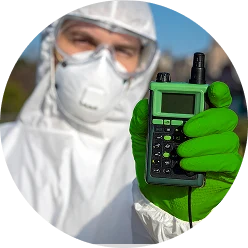
Air Analysis

Water Analysis

Soil Analysis

Radiology

Workplace Analysis

Waste Hazard Analysis
Services of LLC “All-Ukrainian Environmental Company” for Business:
Search Analyses
No results. Try a different query.
Check Price
Our laboratory, LLC “All-Ukrainian Environmental Company,” holds a Certificate of Competence Confirmation issued by
SE “Zhytomyrstandartmetrology” of the Ministry of Economy of Ukraine, dated 01.09.2023 No. 032/2023, which certifies its technical competence, reliability, and compliance with national standards for conducting measurements.
Therefore, its measurements are recognized as valid by all authorities, including government bodies.
Modern equipment allows for precise measurements within short timeframes.
For over 10 years, we have been conducting measurements and analyses, with experience across various business sectors: industrial enterprises, agriculture, construction, retail, and more.
In our work, we apply a comprehensive approach, as we also provide services for the development of environmental and technical documentation for enterprises.
This reduces the number of contractors, minimizes bureaucratic workload, and allows us to immediately focus on task execution.
Waste Hazard Analysis
According to paragraph 13 of the Waste Classification Procedure approved by the Resolution of the Cabinet of Ministers of Ukraine dated October 20, 2023, No. 1102, a waste generator, in the presence of mirror codes, may classify waste under a code without the “*” symbol only if laboratory test reports are provided confirming the absence of hazardous properties.
The results of waste classification are entered by waste owners, generators, and business entities into the Waste Management Information System.

Atmospheric air analysis
Результати пошуку: ()
Organized emissions from stationary sources:
| Names of the quantities being evaluated | Names of the quantities being evaluated |
|---|---|
| Nitrogen dioxide | Mercaptans (as methyl mercaptan) |
| Nitrogen oxides (total, as nitrogen dioxide) | Methacrylic acid |
| Nitrogen oxides | Methanol (methyl alcohol) |
| Asbestos (fine dust form) | Methyl bromide |
| Acrylic acid | Methyl ethyl ketone (butanone-2) |
| Acrolein (propen-2-al-1) | Methyl mercaptan |
| Acrylonitrile (acrylic acid nitrile) | Methyl isobutyl ketone (hexone, 4-methyl-2-pentanone) |
| Methyl sulfide |
| Ammonia | Methyl chloroform (1,1,1-trichloroethane) |
| Amyl acetate (pentyl acetate) | Copper and its compounds |
| Aniline | Naphthalene |
| Anthraquinone | Nickel and its compounds (as nickel) |
| Acetaldehyde (acetic aldehyde) | Ozone |
| Acetone (propanone-2, dimethyl ketone) | Tin and its compounds (as tin) |
| Benz(a)anthracene (tetraphene) | Perchloroethylene (tetrachloroethylene) |
| Benz(a)pyrene (1,2-benzpyrene) | Propanol (propyl alcohol) |
| Benz(a)pyrene (4,5-benzpyrene) | Propyl acetate |
| Gasoline | Propyl propionate |
| Benzene | Substances as suspended solid particles (dust) |
| Biphenyl (diphenyl, phenylbenzene) | Resorcinol |
| Bromine | Mercury |
| Butyl acetate (butyl ester of acetic acid) | Soot |
| Butanol (butyl alcohol) | Lead and its compounds (as lead) |
| Sulfur dioxide |
| Vinyl chloride | Sulfur trioxide |
| Vinyl acetate | Hydrogen sulfide |
| Hydrogen fluoride (hydrofluoric acid) and gaseous fluorine compounds | Carbon disulfide |
| Hydrogen chloride (hydrochloric acid) | Sulfuric acid |
| Hydrogen cyanide (prussic acid) | Turpentine |
| Carbon monoxide | Styrene |
| Carbon tetrachloride (tetrachloromethane, perchloromethane) | Toluene |
| Hydrocarbons: aliphatic C1–C8; aromatic C6–C8 | Tricresol (o-, m-, p-cresols) |
| Kerosene | Toluene diisocyanate |
| Dinyl (Dauterm) | Trichloroethylene (Trichloroethene) |
| Dimethyl sulfide | White spirit |
| Dioctyl phthalate | Phenol |
| Divinyl (1,3-butadiene) | Formaldehyde |
| Diphenylmethane (fluorene) | Phosphine (phosphorous hydrogen) |
| Dibenzofuran (diphenylene oxide) | Phosphorus anhydride |
| Dichloroethane (ethyl chloride) | Freons (Refrigerants 11, 12, 113, 114) |
| Dioxane (1,4-Dioxane) | Phthalic anhydride |
| Ethanol (Ethyl alcohol) | Solid fluorine compounds |
| Epichlorohydrin | Fluorine and its compounds (as fluorine), mg/m3 (%) |
| Ethyl acetate (Ethyl ester of acetic acid) | Phosgene |
| Ethylenediamine | Furfural |
| Ethylene oxide (1,2-Epoxyethane) | Chlorine |
| Ethylbenzene | Chloroform (Trichloromethane) |
| Ethyl cellosolve (2-Ethoxyethanol) | Chromium (III) and its compounds |
| Ethylene glycol (Glycol, Ethane-1,2-diol; Dioxoethane) |
|
| Zinc and its compounds (as zinc) |
| Isobutanol (Isobutyl alcohol) | Cyclohexanone |
| Isopropanol (Isopropyl alcohol) | Nitrogen oxide content |
| Cadmium and its compounds (as cadmium) | Carbon monoxide content |
| Rosin | Oxygen content |
| Caprolactam Caproic acid | Temperature |
| Butyric acid Formic acid | |
| Acetic acid | Gas-dust flow parameters: |
| Propionic acid | Humidity |
| Silicon dioxide | Temperature |
| Velocity and volumetric flow rate |
| Pressure |
| Oil aerosol | Oxygen content |
| Mercaptans (as methyl mercaptan) | Temperature |
Atmospheric air:
| Nitrogen dioxide | Dust (suspended particles of potassium-magnesium fertilizer) |
| Ammonia | Dust (suspended particles), inorganic, containing silicon dioxide 70–20% (fireclay, cement, etc.) |
| Sulfurous anhydride | Dust (suspended particles), inorganic, containing silicon dioxide below 20% (dolomite, etc.) |
| Sulfur dioxide | Dust (suspended particles), grain |
| Acetone | Dust (suspended particles), cotton |
| Butyl acetate | Dust (suspended particles), inorganic, containing silicon dioxide 70% (dinax and others) |
| Gasoline (petroleum, low-sulfur), in terms of carbon | Mercury |
| Benzene | Soot |
| Saturated hydrocarbons (as total organic carbon) | Lead and its compounds |
| Carbon monoxide | Hydrogen sulfide |
| Ethyl acetate | Phenol |
| Iron oxide (as iron) | Formaldehyde |
| Sulfuric acid | Chlorine |
| Xylenes – ortho, meta, para | Hydrogen chloride |
| Methane | Hydrogen fluoride |
| Manganese and its compounds (as manganese dioxide) | Isopropyl alcohol |
| Methyl mercaptan | Toluene |
| Ozone | Hexavalent chromium (as chromium trioxide) |
| Dust (suspended particles) | Cyclohexanone |
| Dust (suspended particles of chitin) | |
Indoor air:
| Nitrogen dioxide | Chlorine |
| Ammonia | Phenol |
| Dust (suspended particles), undifferentiated | Formaldehyde |
| Dust (suspended particles) of chitin | Lead |
| Dust (suspended particles) of potassium-magnesium fertilizer | Oxidizability |
| Dust (suspended particles) inorganic, containing silicon dioxide 70–20% (fireclay, cement, etc.) | Ozone |
| Dust (suspended particles) inorganic, containing silicon dioxide 20% (dolomite, etc.) | Mercury |
| Dust (suspended particles) from cement production | Air temperature |
| INDOOR AIR | Exposure (equivalent) gamma radiation dose rate |
| Annual average equivalent equilibrium volumetric activity (EEVA) of radon-222 in indoor air | |
Factors of the production environment and labor process of the workplace air:
| Nitrogen dioxide | Copper |
| Nitrogen oxides | Methyl acrylate |
| Acrolein | Methyl methacrylate |
| Acrylonitrile | Manganese oxides (as MnO2) (disintegration aerosol) |
| Aluminum and its alloys (as aluminum) | Sodium bicarbonate |
| Aluminum oxide mixed with nickel alloy up to 15% | Sodium chloride |
| Aluminum oxide with impurities of free silicon dioxide up to 15% and iron oxide up to 10% (as condensation aerosol) | Nickel, nickel oxides, sulfides, and mixtures of nickel compounds |
| Aluminum oxide with impurities of silicon dioxide (as condensation aerosol) | Nickel salts in the form of hydroaerosol (as Ni) |
| Acrylamide | Ozone |
| Ammonium chloride | Caustic alkalis (as NaOH) |
| Ammonia | Polymers and copolymers based on acrylic and methacrylic monomers |
| Aniline | Polymers based on styrene |
| Maleic anhydride | Polypropylene (unstabilized) |
| Methacrylic anhydride | Polyethylene |
| Butyric anhydride | Polyvinyl chloride |
| Sulfur anhydride |
|
| Sulfurous anhydride | b) flour, wood, etc. (with silicon dioxide impurities less than 2%) |
| Phosphorus anhydride | c) bast fibers — cotton, flax, wool, down, etc. (with silicon dioxide impurities over 10%) |
| Phthalic anhydride | Metallic mercury |
| Chromic anhydride | Lead and its inorganic compounds (as Pb) |
| Aniline |
|
| Acetaldehyde | b) asbestos rock dust containing up to 10% asbestos |
| Acetone | c) asbestos cement containing no more than 5% manganese dioxide, 7% chromium oxide, 10% iron oxide |
| Gasoline (fuel solvent) | d) asbestos-bakelite, asbestos-rubber |
| Benzene | e) mica (phlogopite, muscovite), talc, talc-bearing dust (natural mixtures of talc with tremolite, actinolite, anthophyllite, etc.) containing up to 10% free silicon dioxide |
| Benz(a)pyrene | f) artificial mineral fibers — silicate and aluminosilicate glassy structures (fiberglass, glass wool, mineral wool, slag wool, etc.) |
| Bromine | g) cement, apatite, clay, chamotte kaolin |
| Butyl acetate | h) glassy volcanic silicates (tuff, pumice, perlite) |
| Butyl methacrylate | i) zeolites (natural and synthetic) |
| Limestone | Hydrogen sulfide |
| Hydrogen chloride | Carbon disulfide |
| Hydrogen fluoride (as F) | Solvent – oil (as C) |
| Hydrogen cyanide | Butyl alcohol |
| Vinyl chloride | Isobutyl alcohol |
| Vinyl acetate | Isopropyl alcohol |
| Tungsten, tungsten carbide and silicide | Ethyl alcohol |
| Tungsten sulfide and disulfide | Methyl alcohol |
| Aliphatic hydrocarbons C1 – C10 (as C) | Propyl alcohol |
| Carbon monoxide | Fiberglass-reinforced polyester |
| Carbon dioxide | Toluene |
| Toluene diisocyanate |
| b) anthracite with up to 5% free silica | Trichloroethylene |
| c) other fossil coals and carbonaceous dust with 5–10% free silica | Tetrachloroethylene |
| d) natural and synthetic diamonds | Titanium and its dioxide |
| e) metallized diamond | Tetrafluorodibromomethane (Freon 114B2) |
| f) industrial black soot with ≤35 mg benz(a)pyrene per 1 kg | Tetramethylthiuram disulfide (Thiram D, TMTD) |
| g) carbon fiber materials based on hydrated cellulose fibers | Styrene |
| h) carbon fiber materials based on polyacrylonitrile fibers | Sodium carbonate (soda ash) |
| Hexane | Phenol |
| Hydrazine and its derivatives | Phenol |
| Hexachlorocyclohexane (hexachlorane, chlorine-containing pesticides, DDT, DDD) | Formaldehyde |
| Glutaric dialdehyde |
|
| Dibutyl phthalate | b) aluminum, magnesium, calcium, strontium, copper, chromium, yttrium, terbium, lutetium, and scandium fluorides |
| Diethylamine | Barium ferrite, magnesium–manganese ferrite, manganese–zinc ferrite, nickel–copper ferrite, nickel–zinc ferrite |
| Dichloroethane | White spirit (as C) |
| Dioctyl phthalate | Carbon tetrachloride |
| Dolomite | Chlorpyrifos (Dursban) |
| Iron (metallic) | Chlorine |
| Oil shale ash | Chromium oxide (as Cr +3) |
| Ethylene glycol | Chromates, bichromates (as CrO3) |
| Iodine | Zinc oxide |
| Isoprene | Cyclohexane |
| Calcium hydroxide (slaked lime) | Cyclohexanone |
| Cadmium and its compounds | Ethyl acrylate |
| Rosin | Zirconium and its compounds |
| Camphor | Ethyl acetate |
| Capron (polyamide-6) | Ethylene oxide |
| Carbamide (urea) | Ethyl cellosolve |
| Caprolactam | Ethyl mercaptan |
| Ceramics | Epichlorohydrin |
| Kerosene | Ethyl acrylate |
| Acrylic acid | Calcium oxide |
| Methacrylic acid | Cast iron mixed with electrocorundum up to 20% |
| Sebacic acid | Chromium-doped electrocorundum |
| Sulfuric acid | Iron oxide |
| Acetic acid | 4,4 – diphenylmethane diisocyanate |
| Formic acid | |
| Boric acid | Welding aerosol:
|
| Cobalt | Iron oxide |
| White corundum | Cobalt and its inorganic compounds |
| Amorphous silicon dioxide as condensation aerosol with content over 60% | Manganese and its compounds (up to 20%) |
| Amorphous silicon dioxide as condensation aerosol with content from 10% to 60% | Copper |
| Amorphous silicon dioxide mixed with manganese oxides as condensation aerosol (each not more than 10%) | Nickel |
| Amorphous and glassy silicon dioxide as disintegration aerosol (diatomite, quartz glass, fused quartz, tripoli) | Nitrogen oxides (as NO2) |
| Crystalline silicon dioxide (quartz, cristobalite, tridymite) with dust content above 70% (quartz, dinas, etc.) | Nitrogen dioxide |
| Crystalline silicon dioxide with content from 10 to 70% (granite, neamot, raw mica, carbon dust, etc.) | Chromium oxide (III) |
| Crystalline silicon dioxide with dust content from 2 to 10% (combustible kukersite shale, copper-sulfide ores, etc.) | Chromium oxide (VI) |
| Silicon carbide (carborundum) | Ozone |
| Calcium oxide | Fluorine acid salts (hydrofluoric acid salts) |
| Xylene | Aluminum and aluminum oxide |
| Metaphos (Parathion-methyl) | Titanium and its dioxide |
| Malathion (Carbophos) | Zinc oxide |
| Mineral petroleum oils | Carbon oxide |
| Methyl ethyl ketone | Lead and its compounds |

Water analysis
Результати пошуку: ()
Drinking water (tap water):
| Aluminum | Permanganate oxidizability |
| Ammonium | Polyphosphates |
| Total hardness | pH |
| Color | Mercury |
| Total iron | Lead |
| Taste and aftertaste |
| Cadmium | Sulfates |
| Turbidity | Dry residue |
| Manganese | Formaldehyde |
| Arsenic | Fluorides |
| Copper | Residual chlorine, free |
| Petroleum products | Residual chlorine, bound |
| Nitrates | Chlorides |
| Nitrites | Zinc |
Drinking water (from wells):
| Ammonium | Permanganate oxidizability |
| Total hardness | pH |
| Color | Taste and aftertaste |
| Total iron | Sulfates |
| Dry residue |
| Turbidity | Fluorides |
| Manganese | Residual chlorine, free |
| Nitrates | Residual chlorine, bound |
| Nitrites | Chlorides |
Water from open water bodies (surface water):
| Ammonium (ammonium nitrogen, ammonia) | Molybdenum |
| Aluminum | Petroleum products |
| Anionic synthetic surfactants | Nickel |
| Biochemical oxygen demand (BOD) | Nitrates |
| Boron | Nitrites |
| Vanadium | Transparency |
| Hydrogen index (pH) | Thiocyanates |
| Hardness | Lead |
| Suspended solids | Hydrogen sulfide (sulfides) |
| Iron | Silver |
| Odor | Sulfates |
| Cadmium | Dry residue |
| Calcium | Temperature |
| Dissolved oxygen | Polyphosphates |
| Cobalt | Phenols |
| Color | Formaldehyde |
| Silicon | Chemical oxygen demand (COD) |
| Total alkalinity | Chlorides |
| Magnesium | Chromium (total, (III) and (VI)) |
| Manganese | Cyanides |
| Copper | Zinc |
Wastewater (return water):
| Ammonium nitrogen | Molybdenum |
| Anionic synthetic surfactants | Petroleum products |
| Aluminum | Nickel |
| Biochemical oxygen demand (BOD) | Nitrates |
| Boron | Nitrites |
| Vanadium | Tin |
| Bismuth | Polyphosphates |
| Hydrogen index (pH) | Thiocyanates |
| Fats and oils | Lead |
| Hardness | Hydrogen sulfide (sulfides) |
| Suspended solids | Silver |
| Iron | Sulfates |
| Odor | Dry residue (mineralization) |
| Cadmium | Temperature |
| Calcium | Phenols |
| Dissolved oxygen | Formaldehyde |
| Color | Fluorides |
| Cobalt | Chemical oxygen demand (COD) |
| Silicon | Chlorides |
| Magnesium | Chromium (total, (III) and (VI)) |
| Manganese | Cyanides |
| Copper | Zinc |
Industrial wastewater of enterprises:
| Ammonium nitrogen (ammonia as nitrogen) | Nitrates |
| Aluminum | Nitrites |
| Biochemical oxygen demand (BOD5) | Tin |
| Hydrogen index (pH) | Thiocyanates |
| Vegetable and animal fats | Lead |
| Suspended solids | Hydrogen sulfide (sulfides) |
| Iron (total) | Silver |
| Odor | Surfactants (anionic, nonionic) |
| Cadmium | Sulfates |
| Calcium | Temperature |
| Color | Phenols |
| Cobalt | Formaldehyde |
| Silicon | Fluorides |
| Magnesium | Phosphates |
| Manganese | Chlorides |
| Copper | Chromium 6+ |
| Mineralization | Chromium (total) |
| Molybdenum | Chemical oxygen demand (COD) |
| Petroleum products | Cyanides |
| Nickel | Zinc |

Soil analysis
Результати пошуку: ()
Soils:
| Nitrogen (total) | Manganese (exchangeable) |
| Ammonium (exchangeable), recalculated as ammonium nitrogen | Copper (mobile forms) |
| Anionic surfactants (AS) | Nonpolar hydrocarbons (petroleum products) |
| Hydrogen index pH (water extract) | Nitrates (alum-potassium extract), recalculated as nitrates |
| Hydrogen index pH (salt extract) | Lead (mobile forms) |
| Iron (mobile form) | Chlorides (water extract) |
| Exchangeable acidity | Zinc (mobile form) |

Radiology
Результати пошуку: ()
Forestry products:
| Specific activity of natural radionuclides | Cesium-137 |
Paper and cardboard products:
| Total specific activities of radium, thorium, potassium, and cesium |
Glass, products made of glass, porcelain, faience, and clay:
| Total specific activities of radium, thorium, and uranium |
Mineral building raw materials and materials:
| Total specific activities of radium, thorium, and uranium |
Construction sites:
| Exposure (equivalent) dose rate of gamma radiation | Beta radiation flux density |

Analysis of production environment factors
Результати пошуку: ()
Factors of the production environment and labor process of the workplace air:
| Nitrogen dioxide | Copper |
| Nitrogen oxides | Methyl acrylate |
| Acrolein | Methyl methacrylate |
| Acrylonitrile | Manganese oxides (as MnO2) (disintegration aerosol) |
| Aluminum and its alloys (as aluminum) | Sodium bicarbonate |
| Aluminum oxide mixed with nickel alloy up to 15% | Sodium chloride |
| Aluminum oxide with impurities of free silicon dioxide up to 15% and iron oxide up to 10% (as condensation aerosol) | Nickel, nickel oxides, sulfides, and mixtures of nickel compounds |
| Aluminum oxide with impurities of silicon dioxide as condensation aerosol | Nickel salts as hydroaerosol (as Ni) |
| Acrylamide | Ozone |
| Ammonium chloride | Caustic alkalis (as NaOH) |
| Ammonia | Polymers and copolymers based on acrylic and methacrylic monomers |
| Aniline | Polymers based on styrene |
| Maleic anhydride | Polypropylene (unstabilized) |
| Methacrylic anhydride | Polyethylene |
| Butyric anhydride | Polyvinyl chloride |
| Sulfur anhydride |
|
| Sulfurous anhydride | b) flour, wood, etc. (with silicon dioxide impurities less than 2%) |
| Phosphoric anhydride | c) bast — cotton, flax, wool, down, etc. (with silicon dioxide impurities more than 10%) |
| Phthalic anhydride | Metallic mercury |
| Chromium anhydride | Lead and its inorganic compounds (as Pb) |
| Aniline |
|
| Acetaldehyde | b) asbestos rock dust containing up to 10% asbestos |
| Acetone | c) asbestos cement containing not more than 5% manganese dioxide, 7% chromium oxide, and 10% iron oxide |
| Gasoline (fuel solvent) | d) asbestos bakelite, asbestos rubber |
| Benzene | e) micas (phlogopite, muscovite), talc, talc rock dust (natural mixtures of talc with tremolite, actinolite, anthophyllite, and other minerals) containing up to 10% free silicon dioxide |
| Benz(a)pyrene | f) artificial mineral fibers of silicate and aluminosilicate glassy structures (fiberglass, glass wool, mineral and slag wool, etc.) |
| Bromine | g) cement, apatite, clay, kaolin chamotte |
| Butyl acetate | h) glassy silicates of volcanic origin (tuff, pumice, perlite) |
| Butyl methacrylate | i) zeolites (natural and artificial) |
| Limestone | Hydrogen sulfide |
| Hydrogen chloride | Carbon disulfide |
| Hydrogen fluoride (as F) | Solvent – petroleum (as C) |
| Hydrogen cyanide | Butyl alcohol |
| Vinyl chloride | Isobutyl alcohol |
| Vinyl acetate | Isopropyl alcohol |
| Tungsten, tungsten carbide and silicide | Ethyl alcohol |
| Tungsten sulfide and disulfide | Methyl alcohol |
| Aliphatic hydrocarbons C1 – C10 (as C) | Propyl alcohol |
| Carbon monoxide | Fiberglass based on polyester resin |
| Carbon dioxide | Toluene |
| Toluylene diisocyanate |
| b) anthracite containing up to 5% free silicon dioxide | Trichloroethylene |
| c) other fossil coal and carbonaceous rock dust containing up to 5% and from 5% to 10% free silicon dioxide | Tetrachloroethylene |
| d) natural and synthetic diamonds | Titanium and its dioxide |
| e) metallized diamond | Titanium tetrachloride |
| f) industrial black carbon containing not more than 35 mg of benzo(a)pyrene per 1 kg | Tetrafluorodibromomethane (Freon 114B2) |
| g) carbon fiber materials based on hydrated cellulose fibers | Tetramethylthiuram disulfide (Thiram D, TMTD) |
| h) carbon fiber materials based on polyacrylonitrile fibers | Styrene |
| Hexane | Soda ash |
| Hydrazine and its derivatives | Phenol |
| Hexachlorocyclohexane (HCH, chlorinated pesticides, DDT, DDD) | Formaldehyde |
| Glutaraldehyde |
|
| Dibutyl phthalate | b) fluorides of aluminum, magnesium, calcium, strontium, copper, chromium, yttrium, terbium, lutetium, scandium |
| Diethylamine | Barium ferrite, magnesium-manganese ferrite, manganese-zinc ferrite, nickel-copper ferrite, nickel-zinc ferrite |
| Dichloroethane | White spirit (as C) |
| Dioctyl phthalate | Carbon tetrachloride |
| Dolomite | Chlorpyrifos (Dursban) |
| Iron (metallic) | Chlorine |
| Ash of oil shales | Chromium oxide (as Cr +3) |
| Ethylene glycol | Chromates, bichromates (as CrO3) |
| Iodine | Zinc oxide |
| Isoprene | Cyclohexane |
| Calcium hydroxide (slaked lime) | Cyclohexanone |
| Cadmium and its compounds | Ethyl acrylate |
| Rosin | Zirconium and its compounds |
| Camphor | Ethyl acetate |
| Capron | Ethylene oxide |
| Urea (carbamide) | Ethyl cellosolve |
| Caprolactam | Ethyl mercaptan |
| Ceramics | Epichlorohydrin |
| Kerosene | Ethyl acrylate |
| Acrylic acid | Calcium oxide |
| Methacrylic acid | Cast iron mixed with electrocorundum up to 20% |
| Sebacic acid | Chromium electrocorundum |
| Sulfuric acid | Iron oxide |
| Acetic acid | 4,4-Diphenylmethane diisocyanate |
| Formic acid | |
| Boric acid | Welding aerosol:
|
| Cobalt | Iron oxide |
| White corundum | Cobalt and its inorganic compounds |
| Amorphous silicon dioxide as condensation aerosol with content above 60% | Manganese and its compounds up to 20% |
| Amorphous silicon dioxide as condensation aerosol with content from 10% to 60% | Copper |
| Amorphous silicon dioxide mixed with manganese oxides as condensation aerosol, each content not more than 10% | Nickel |
| Amorphous and glassy silicon dioxide as disintegration aerosol (diateleit, quartz glass, fused quartz, tripoli) | Nitrogen oxides (as NO2) |
| Crystalline silicon dioxide (quartz, cristobalite, tridymite) with dust content over 70% (quartz, dinas etc.) | Nitrogen dioxide |
| Crystalline silicon dioxide with content from 10% to 70% (granite, neamot, mica – raw, carbon dust, etc.) | Chromium oxide (III) |
| Crystalline silicon dioxide with dust content from 2% to 10% (combustible kukersite shales, copper sulfide ores, etc.) | Chromium oxide (VI) |
| Silicon carbide (carborundum) | Ozone |
| Calcium oxide | Salts of hydrofluoric acid |
| Xylene | Aluminum and aluminum oxide |
| Metaphos (Parathion-methyl) | Titanium and its dioxide |
| Malathion (Carbophos) | Zinc oxide |
| Mineral oils (petroleum) | Carbon oxide |
| Methyl ethyl ketone | Lead and its compounds |
Factors of the production environment and labor process of the microclimate in production facilities:
| Temperature | Sound pressure levels in octave frequency bands, sound level, equivalent sound level |
| Relative humidity | General vibration |
| Air velocity | Local vibration |
| Thermal radiation | Illumination |
| Atmospheric pressure | |
Workplaces, residential areas in the zone of radio-technical facilities:
| Magnetic field intensity | Energy flux density |
| Electric field intensity | |
Personnel engaged in practical activities with sources of ionizing radiation:
| Equivalent dose of external radiation |
Factors of the production environment and labor process: psychophysiological factors:
Labor intensity:
| Work strain:
|

Our Clients:
How We Work

Order

Contract

Site Visit and Sample Collection

Analysis: from 3 days

Research Protocol
Services: